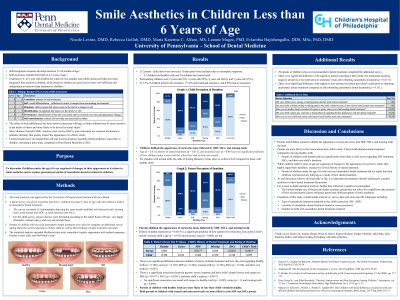Other
102 - Smile Aesthetics in Children Less than 6 Years of Age


Nicole A. Levine, DMD (she/her/hers)
Pediatric Dental Resident
University of Pennsylvania/Children's Hospital of Philadelphia
The University of Pennsylvania School of Dental Medicine
Short Hills, New Jersey, United States- RG
Rebecca Gollub, DMD
Penn Dental Medicine
- EH
Evlambia Hajishengallis, DDS, MSc, PhD, DMD
Penn Dental Medicine
- LM
Leanne Magee, PhD
Children's Hospital of Philadelphia
- EH
Evlambia Hajishengallis, DDS, MSc, PhD, DMD
Division Chief of Pediatric Dentistry and Director of the Postdoctoral Pediatric Program at Penn Den
University of Pennsylvania/CHOP
Philadelphia, Pennsylvania, United States - AO
Alina O'Brien, DDS
Program Director
University of Pennsylvania School of Dental Medicine
Philadelphia, Pennsylvania, United States
Presenting Author(s)
Co-Author(s)
Research Mentor(s)
Program Director(s)
Purpose: To examine the psychological impact of unaesthetic dental treatments on children and their parents.
Methods: A photo-survey depicting unaesthetic dental treatments, including silver diamine fluoride (SDF), stainless steel crowns (SSCs), and extractions, was given to 102 ASA 1 children younger than 6 years old with treated and untreated teeth, as well as to their parents. Parents of children with unaesthetic dental treatment completed an additional survey to examine the psychological sequela of such dental treatments on their children and themselves.
Results: Both parents and children disliked the appearance of caries the most, followed by SDF, SSCs, and missing teeth. There is no significant difference between a children’s history of dental treatment and how they feel regarding healthy teeth, carious teeth, SDF, missing teeth, SSCs, and their own teeth. There is a significant association between parents' survey response and their child’s dental history with respect to SDF (p = 0.017*), SSCs (p = 0.026*), and their child’s teeth (p = 0.001*), but there no significant association was noted with respect to healthy teeth, caries, and missing teeth. No parent reported that their child was being bullied since obtaining unaesthetic dental treatment.
Conclusions: While children under 6 years of age are cognizant of changes to the appearance of a person’s smile, the majority of children feel fantastic about their teeth, even if unaesthetic dental treatment has been rendered. Parents of children with treated teeth are significantly more likely to feel worse regarding SDF, SSCs, and their own child’s dentition. Dentists and parents should consider aesthetic implications when making treatment planning decisions.
Identify Supporting Agency and Grant Number:

.jpg)